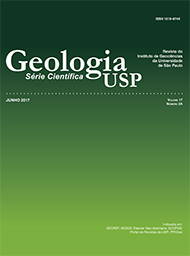Cartografia geofísica regional do magmatismo mesozoico na Bacia do Parnaíba
DOI:
https://doi.org/10.11606/issn.2316-9095.v17-455Palavras-chave:
Magnetometria, Sísmica de Reflexão, Mapeamento Semiautomático, Susceptibilidade Magnética, Formações Mosquito e Sardinha, Bacia do Parnaíba.Resumo
Durante a desagregação mesozoica do megacontinente Pangea e abertura do Oceano Atlântico, rochas ígneas intrusivas e extrusivas acomodaram-se na Bacia do Parnaíba no Eojurássico e Eocretáceo, resultando nas sucessões ígneas Mosquito e Sardinha, respectivamente. O principal objetivo desta pesquisa é a cartografia geofísica regional desses corpos magmáticos com base em técnicas de realce de anomalias magnéticas e mapeamento semiautomático (SOM). Um vasto conjunto de dados magnéticos aerolevantados foi processado e interpretado com o objetivo de cartografar a distribuição da atividade ígnea na Bacia do Parnaíba. Os mapas geofísicos resultantes indicam que o magmatismo mosquito tem proeminente ocorrência nas bordas oeste e sul da bacia, enquanto que o magmatismo sardinha está concentrado nas porções centro-leste e nordeste. Dados de susceptibilidade magnética das rochas magmáticas permitiram individualizar os dois principais eventos magmáticos mesozoicos, constatando que a Formação Sardinha exibe susceptibilidade magnética média aproximadamente duas vezes maior que a Formação Mosquito, revelando uma diferenciação composicional desses dois eventos magmáticos. Análise comparativa entre seções sísmicas, dados magnéticos e geológicos de superfície revela que a ocorrência das rochas magmáticas é muito mais extensa em subsuperfície e que soleiras e diques ocorrem principalmente intercalados entre as sequências tectono-sedimentares paleozoicas. As direções dos lineamentos magnéticos revelaram a possível ocorrência de feições riftes de direções ENE-WSW e NNE-SSW, associados à desagregação do Gondwana Oeste, e <i>trends</i> estruturais E-W e NE-SW, associados a zonas de cisalhamento brasilianas. Essa herança tectônica controlou parcialmente o alojamento do magmatismo mesozoico na Bacia do Parnaíba. Por fim, estruturas rifte sotopostas discordantemente sob as sequências sedimentares demostram uma relação próxima com as direções magnéticas orientadas para ENE-WSW e NNE-SSW. Por outro lado, anisotropias profundas associadas ao Lineamento Transbrasiliano revelaram <i>trends</i> estruturais E-W e NE-SW, governando o padrão de alojamento do magmatismo mesozoico na Bacia do Parnaíba.
Downloads
Publicado
Edição
Seção
Licença
Autores que publicam nesta revista concordam com os seguintes termos:
- Autores mantém os direitos autorais e concedem à revista Geologia USP. Série Científica, o direito de primeira publicação, com o trabalho sob a licença Creative Commons BY-NC-SA (resumo da Licença: https://creativecommons.org/licenses/by-nc-sa/4.0 | texto completo da licença: https://creativecommons.org/licenses/by-nc-sa/4.0/legalcode) que permite o compartilhamento do trabalho de forma não comercial e conferindo os devidos créditos autorais da primeira publicação nesta revista.
- Autores têm autorização para assumir contratos adicionais separadamente, para distribuição não-exclusiva da versão do trabalho publicada nesta revista (publicar em repositório institucional ou como capítulo de livro), conferindo os devidos créditos autorais da primeira publicação nesta revista.
- Autores têm permissão e são estimulados a publicar e distribuir seu trabalho online (em repositórios institucionais ou na sua página pessoal) a qualquer ponto antes ou durante o processo editorial, uma vez que isso pode gerar alterações produtivas, bem como aumentar o impacto e a citação do trabalho publicado (Veja O efeito do Acesso Aberto e downloads no impacto das citações).















